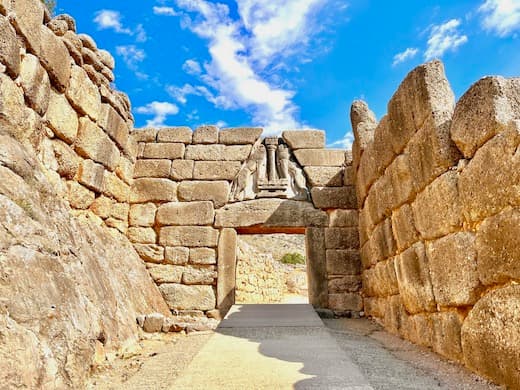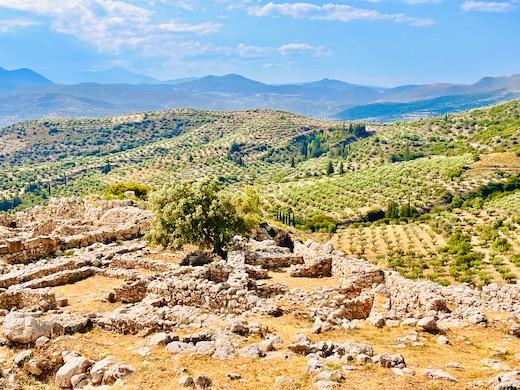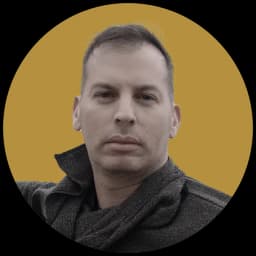Your Weekend in Ruins: The Road to Mycenae From Marathonas
On a seaside Attica plain, the clash of shields and spears has been replaced by haunting silence.

MARATHONAS, Greece — Amid weird weather, war, and rising prices, Europe in the summer of 2023 is proving to be more popular than a fire sale at Filene’s Basement. (Remember those?) Hotels on the Continent are selling out and cheap airfares are elusive, but the tourist hordes keep coming.
Yesterday’s battles, of course, furnish Instagram moments for the future. That is one thought, among many, that came to mind as I swerved my leased, somewhat automatic car into a parking lot 26 miles north of Athens — having been made to understand by a kind farmer I was driving in the wrong direction — and found myself staring at the Tumulus of the Marathon Warriors.
It is the simplest reminder of an epic showdown that transpired on this seaside plain of Attica about 2,500 years ago, when badly outnumbered Greek warriors thrashed a hodgepodge Persian force dispatched by Darius I.
On September 10 (it is widely thought), 490 B.C., an estimated 11,000 hoplites under the brilliant command of Miltiades charged down a mountaintop in phalanx formations that threw the more than 25,000 Persian infantry and cavalry off guard. When the dust had settled, some 6,400 Persian warriors were dead while the Greeks counted 192 Athenian citizens and 11 Plataeans among their losses.
Contrary to the common burial practice of the time, the fallen heroes of the Battle of Marathon were cremated: Excavations in 1884 and in the early 1890s uncovered a thick layer of ash and charred bones in the burial mound here that is also known as a polyandreion.
The messenger Pheidippides, of course, ran 26 miles to an anxious Athens from the Marathonas battlefield to announce the Greek victory over Persia. He also collapsed and subsequently expired from the exertion, but not before making his point. In less than a day, the world had changed.
The clash of shields and spears here has long since been replaced by a haunting silence, and the man at the ticket counter confirmed to me that the site is reportedly haunted. I do not disbelieve it. The bravery as well as ingenuity that the Greeks displayed here so long ago is as much a part of the Greek national consciousness today as the Greatest Generation is to ours. It is an unmistakably solemn air that prevails here, and not something one will find, say, at the heavily touristed Acropolis.
There is also a great beach nearby at Schinias, where incidentally the Persians who had not been crushed in the carnage beat a hasty retreat back to their boats. The marsh they had to lumber across to get to the water’s edge is still there.
Like most ancient sites in this part of the world, Marathonas is multilayered. The fallen Greek fighters from nearby Plataea — the Spartans couldn’t be bothered this time around — were for mysterious reasons buried elsewhere, so I went looking for them.
My path took me first to the small Archaeological Museum of Marathonas, which sits at the bottom of the peak from which the Greek hoplites descended to battle the Persians, who had been encamped on the plain. Prominently displayed in the central atrium is what remains of the marble trophy — an Ionic column originally 32 feet high with a statue of Nike on top — that was erected nearby in the years following the Athenian victory.
There are also grave goods such as black figure vases and kylikes, or wine cups, that were discovered beneath the two Marathon tumuli.
Yes, there is a second battle tumulus, and I was starting to despair at not being able to find it. But closer inspection of my maps showed it was closer than I thought. The security guard wasn’t too busy — there were no other visitors on the day I was there — so he volunteered to show me the way. A happy old dog followed us across a sort of prairie, peppered in the typical late-spring Attica way with olive trees, red poppies with drooping petals, and loose stones.
A few hundred yards from the main museum building, we arrived at a small earthen mound with a locked door. Stavros, the guard, had the key.
The Plataeans who fell in the Battle of Marathon, unlike the Athenians, were not cremated, as I realized with a chill when the door swung open and the skeletons came into view. In the 1970 excavations the archaeologist Spyridon Marinatos uncovered this Grecian tomb containing five perfectly preserved skeletons.
He showed a throng of reporters then, the New York Times reported, the skull of a sixth warrior that appeared to bear the marks of the Persian arrow that likely killed him. “The dead we found are the heroes of one battle that saved civilization,” the archaeologist said a half-century ago.
The skeletons today are glass-encased in situ, so you can peer at them from above — assuming the door is unlocked or you can find somebody who has the key.

About the only thing that ancient Mycenae has in common with Marathonas is that whistling, haunting silence, but it is tuned to a different frequency, and you cannot always hear it. That is because the Bronze Age citadel, in the Peloponnese south of Athens, is squarely on the mass tourism circuit. To avoid the throngs of tourists belched out by the monster cruise ships that call at Piraeus to the north, it is best to arrive very late in the day.
In summertime that is easy to do, as like most ancient sites in these parts it is open until 8 p.m. all season long.
A couple of hours are enough to behold the iconic if sternly decorated Lion Gate and potter about the stony ruins of one of the epicenters of ancient Greek civilization. Skip the museum, because the most important Mycenaean relics like the gold funeral mask of Agamemnon are up at Athens, at the National Archaeological Museum.
Mycenae is situated in the Argolis, a rugged, fertile, peninsular region that borders Arcadia on the west and includes the ancient site of Epidaurus, or Epidavros, with its famed ancient theater, and Asclepieion, or sanctuary of healing, to the east.
The palace walls and temple columns at Mycenae fell down a long time ago. Yet from the top of the citadel the sweeping view over the citrus orchards and silvery-green olive groves to the blue Argolic Gulf fits a certain definition of ravishing. Not a bad place to park the headquarters of a civilization that, while long gone, still ripples, at various speeds, across time.

